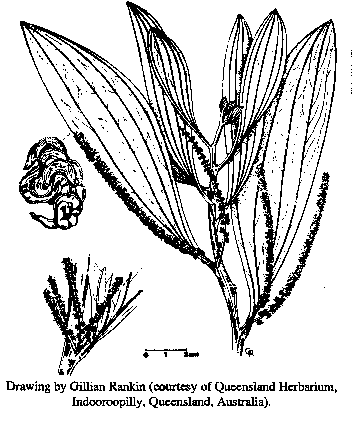Acacia mangium: an important multipurpose tree for the tropic lowlands

FACT 96-03, June 1996
A quick guide to multipurpose trees from around the world
Acacia mangium Willd. is one of the major fast growing species used in plantation forestry programs throughout Asia and the Pacific. Due to its rapid growth and tolerance of very poor soils, A. mangium is playing an increasingly important role in efforts to sustain commercial supply of tree products while reducing pressure on natural forest ecosystems.

Botany
Acacia mangium is in the family Leguminosae, sub-family Mimosoideae. It has rapid early growth, and can attain a height of 30 meters and a diameter of over 60 centimeters (MacDicken and Brewbaker 1984). Inflorescences are on loose spikes up to 10 cm long with white or cream colored flowers. When in full blossom, the inflorescences resemble bottle brushes. The flower has a mild, sweet fragrance. The dark green, glabrous phyllodes can be up to 25 cm long and 10 cm broad. The seed pods are broad, linear, irregularly coiled, and up to 3-5 mm wide and 7-8 cm long. The seeds are dark brown to black, shiny, vary in shape, and range from 3-5 mm long and 2-3 mm wide. Seeds mature 6-7 months after flowering (Pinyopusarerk et al. 1993).
Acacia mangium has a chromosome number of 2n=26. Hybrids with A. auriculiformis have the potential to become an important source of planting material for plantation forestry. The hybrid seems to be more resistant to heart rot than A. mangium but tends to be more shrub-like. Moreover, the hybrid has the straight bole and stem of Acacia mangium and the self-pruning ability of A. auriculiformis (Ibrahim 1993).
Distribution and Ecology
Acacia mangium is native to Australia, Indonesia and Papua New Guinea, but now has a latitudinal range from 19o S to 24o N and a longitudinal range from 88o to 146o E. Acacia mangium is a low-elevation species associated with rain forest margins and disturbed, well-drained acid soils (pH 4.5-6.5). Altitudinal range is from sea level to about 100 meters, with an upper limit of 780 meters. It is typically found in the humid, tropical lowland climatic zone characterized by a short dry season and a mean annual rainfall between 1446 and 2970 mm. Acacia mangium can tolerate a minimum annual rainfall of 1000 mm. Mean monthly temperatures range from a low of 13-21C and a high of 25-32o C. Though considered an evergreen species, A. mangium does not grow continuously throughout the year. Growth seems to slow or cease in response to the combination of low rainfall and cool temperatures. Dieback occurs during prolonged frost (5-6o C).
Ecology Selected References
Bray, R.A., Palmer, B., Ibrahim, T.M. (1997). Performance of shrub legumes at four sites in Indonesia and Australia. Tropical Grasslands 31(1):31-39.
Brook, R.M. (1993) Alley cropping for sweet potato in Papua New Guinea. Nitrogen Fixing Tree Research Reports 11:35-39.
Brook, R.M., Kanua, M.B., Woruba, M.G. (1992). Multipurpose tree species evaluations in Papua New Guinea: Early results. Nitrogen Fixing Tree Reports 10:77-80.
Cole, T.G., Yost, R.S., Kablan, R., Olsen, T. (1996). Growth potential of twelve Acacia species on acid soils in Hawaii. Forest Ecology and Management 80:175-86.
Dzowela, B.H. (1994) Acacia angustissima a Central American tree that’s going places. Agroforestry Today, 6 (3):13-14.
A full set of references is available from FACT Net
Prepared by D. Preece & R. Brook, School of Agricultural and Forest Sciences, University of Wales, Bangor, North Wales, United Kingdom LL57 2UW
Fax: 44 1248 354977
Email: r.m.brook@bangor.ac.uk
A publication of the Forest, Farm, & Community Tree Network (FACT Net)
(formerly the Nitrogen Fixing Tree Association)
